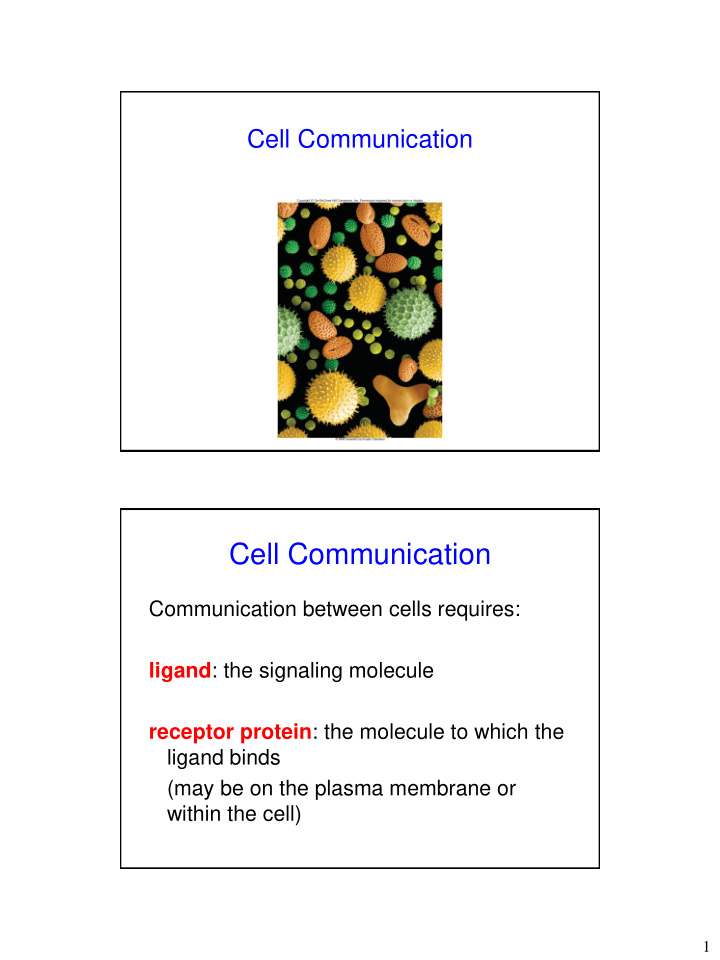



Cell Communication Cell Communication Communication between cells requires: ligand : the signaling molecule receptor protein : the molecule to which the ligand binds (may be on the plasma membrane or within the cell) 1
Figure 9.1 Cell Communication There are four basic mechanisms for cellular communication: 1. direct contact 2. paracrine signaling 3. endocrine signaling 4. synaptic signaling 2
Cell Communication Direct contact – molecules on the surface of one cell are recognized by receptors on the adjacent cell Cell Communication Paracrine signaling – signal released (ligand) from a cell has an effect on neighboring cells 3
Cell Communication Endocrine signaling – hormones (ligands) released from a cell affect other cells throughout the body Cell Communication Synaptic signaling – nerve cells release the signal ( neurotransmitter = ligand ) which binds to receptors on nearby cells 4
Cell Communication Three Stages of Cellular Communication 1.Reception a. Ligand binds to a receptor b. Receptors are either embedded on plasma membrane or within the cell 2.Transduction a. Usually includes a series of steps b. Like dominos falling in a circuit 3.Cellular Response a. Depends on the cell type Receptor Types Receptors can be defined by their location. intracellular receptor – located within the cell cell surface receptor or membrane receptor – located on the plasma membrane to bind a ligand outside the cell 5
Receptor Types There are 4 subclasses of membrane receptors: 1. Ion channel linked receptors – ion channel that opens in response to a ligand 2. Enzymatic receptors – receptor is an enzyme that is activated by the ligand 3. G protein-linked (coupled) receptor – a G-protein (bound to GTP) assists in transmitting the signal Figure 9.4 6
G-Protein Coupled Receptors G-protein – protein bound to GTP G-protein-coupled receptor (GPCRs) – receptors bound to G proteins -G-protein is a switch turned on by the receptor -G-protein then activates an effector protein (usually an enzyme) Figure 9.11 7
Receptor Kinases 4. Tyrosine Kinase Receptors -membrane receptor -when bound by ligands, the receptor is activated by dimerization and autophosphorylation (usually from ATP) -activated receptor adds a phosphate to tyrosine on a response protein -an example is the insulin receptor Figure 9.6 8
Figure 9.7 Intracellular Receptors steroid hormones -have a nonpolar, lipid-soluble structure -can cross the plasma membrane to a steroid receptor (in cytoplasm) -usually affect regulation of gene expression An inhibitor blocks the receptor from binding to DNA until the hormone is present. 9
Intracellular Receptors A steroid receptor has 3 functional domains: 1. hormone-binding domain 2. DNA binding domain 3. domain that interacts with coactivators to affect gene expression Figure 9.5 10
Transduction Second stage of cell communication = Transduction When a ligand binds to a receptor protein, the cell has a response. signal transduction : the events within the cell that occur in response to a signal that will eventually lead to the cellular response Different cell types can respond differently to the same signal. Transduction A cell’s response to a signal often involves activating or inactivating proteins. Phosphorylation is a common way to change the activity of a protein. protein kinase – an enzyme that adds a phosphate to a protein (activation) phosphatase – an enzyme that removes a phosphate from a protein (deactivation) 11
Transduction kinase cascade – a series of protein kinases that phosphorylate each other in succession MAP kinases are activated by kinase cascades Amplification results because because a few signal molecules can elicit a large cell response Figure 9.8a 12
Figure 9.8b Transduction: Second Messengers Once activated, the effector protein sometimes produces a second messenger . -second messenger generates the cellular response to the original signal For example – one common effector protein is adenylyl cyclase which produces cAMP as a second messenger. Other second messengers: IP 3 , calcium ions (Ca 2+ ) 13
Figure 9.13 Cellular Response • Last stage of Cellular Communication 1. Examples of cellular responses: Gene expression – turn on a. transcription/translation b. Synthesis or Breakdown of something c. Transmission of a stimulus Body system response – sweating, immune d. response, hormone release, etc… 2. Responses vary by: a. Type of ligand b. Type of receptor c. Type of cell Same ligand and receptor may have different cellular response in different types of cells 14
Recommend
More recommend